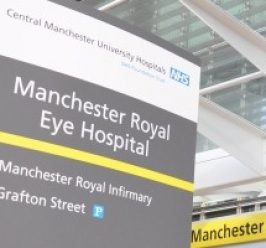The following tests are routinely carried out. Each test takes about 30 minutes but not all patients have all tests performed. It depends on the clinical question being asked. We also spend up to half an hour on preliminary tests where we measure such things as visual acuity and colour vision.
Visual Evoked Potentials (VEPs)
This is a way of analysing brain waves which occur when the patient looks at a moving pattern on a screen or at a flashing light. By correlating the brain responses with the stimulus we can check the function of the optic nerves and the seeing part of the brain. The sensors are attached to the scalp using a harmless and easily-removed adhesive paste.
Flash Electroretinograms (ERGs)
By recording from sensors placed close to the eye we can analyse the electrical signals produced by the eye in response to flashing lights. Part of this test is carried out in the light, and part of it follows a period of 15-20 minutes adaptation to darkness. Thus we are able to analyse the overall function of the retina’s light-sensitive layer (the photoreceptors, or rods and cones). Two sensors are taped to the temples. We then lay a fine thread along the lower eyelid so that it rests against the eye or (with younger patients) attach a small sensor to the skin of the lower eyelid. This test is routinely conducted with dilated pupils, for which drops are put in the eye. Because these drops tend to cause some temporary blurring as well as enlarging the pupils, we recommend that patients do not drive themselves to their appointment.
Pattern Electroretinograms (pERGs)
Using the same sensors as the flash ERG, but a patterned stimulus, we can further analyse the function of the optic nerve and the macula (the very sensitive central portion of the retina).
Electro-oculograms (EOGs)
This is another test of retinal function and is used to assess the integrity of the retinal pigment epithelium (RPE). This is the layer of the retina which nourishes the light-sensitive cells. Sensors are placed on the skin either side of each eye and the patient is asked to make a series of guided eye-movements at intervals over a period of about half an hour. Half the time is spent in darkness, and half in bright light.
Testing Children
We try to tailor the tests to the ability of the patient, and routinely just do VEPs and flash ERGs with younger children. They can sit on a parent’s lap throughout the procedure. During the test we can play videos or music which encourages the patient to look at the test stimulus.
Children can bring their own video tapes, DVDs or CDs, and it is also a good idea to bring along a drink, a snack and a spare nappy (if used). A favourite toy (preferably small and noisy) can help us encourage the child to look at the stimulus. We have baby changing facilities in the unit.
A fun and informative video that will inform children of what happens can be found below.
Staff
Professor Neil Parry

